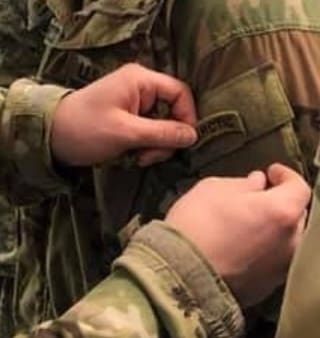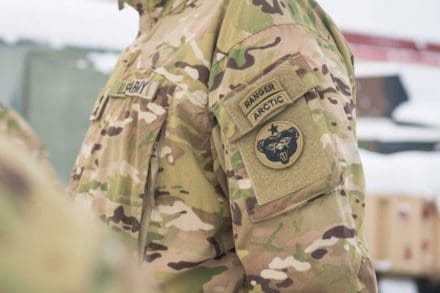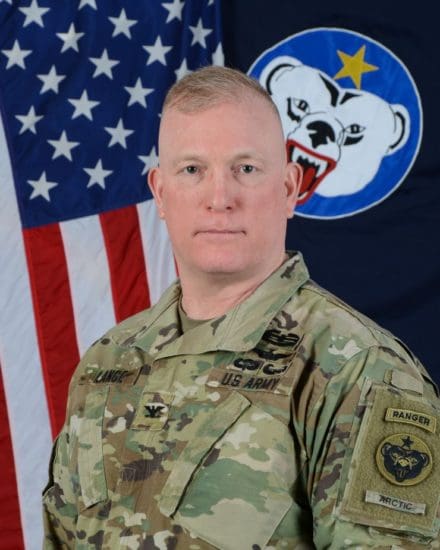The Arctic Tab, a visual representation of a Soldier’s ability to train and thrive in cold environments, just got an upgrade.

Not only does the tab have a new look, it can now be worn outside the confines of the Last Frontier thanks to a new U.S. Army Pacific policy.
According to the policy, approved in February 2020 by USARPAC Commander, Gen. Paul J. LaCamera, Arctic Operations-qualified Soldiers assigned to USARPAC units, including major subordinate commands and direct-reporting units, can now wear the Arctic Tab while serving at USARPAC installations throughout its areas of operation. However, wear is not authorized when Soldiers are on temporary duty or deployment status outside the USARPAC theatre.
The new policy does more than expand where and how the Arctic Tab is worn. It reflects the importance of the U.S. Army’s ability to train and fight in an arctic environment.
“I think what makes U.S. Army Alaska and our units unique is that we are the Army’s proponent for cold weather training,” said Maj. Gen. Peter B. Andrysiak Jr., U.S. Army Alaska commander. “We not only live here; we thrive here, and I want to make sure the tab properly recognizes our unique expertise.”

Originally worn below a Soldier’s unit patch, the Arctic Tab now rests above the patch, joining other prominent skills tabs such as the Ranger or Sapper Tabs. The previously rectangular-shaped tab was redesigned in November 2019 and now also sports the familiar rainbow arc of similar tabs.

The original version of the Arctic tab can be seen above, worn by COL Adam Lange, Deputy Commander, Sustainment, US Army Alaska.
A group of Soldiers who graduated the Northern Warfare Training Center’s Cold Weather Leaders Course, Jan. 17, 2020, became the first to wear the redesigned tab. The NWTC trains units and leaders in cold weather and mountain operations to increase warfighting capabilities. Learning those skills is vital for USARAK leaders at every level.
“As a leader, it is important I know and understand the harsh, arctic conditions and the impact it can have on Soldiers and equipment,” said Capt. Robin Furrer, a recent graduate of CWLC, “Soldiers operate and move differently when it is minus 25 out, and our equipment does as well. So it is important for us to have the knowledge to plan, make decisions, and adapt to these conditions.”
Although the look and placement of the tab has changed, what it takes to earn it remains the same.
Soldiers earn the Arctic Tab after completing either the CWLC or the Cold Weather Orientation Course held at the Black Rapids Training Site run by USARAK’s NWTC instructors. Upon graduating either course, Soldiers are qualified to implement basic, cold weather and ski training programs within their units to help mitigate the unique challenges they face while operating in harsh conditions.
“Anything can fail, even on the coldest days,” Steve Decker, an NWTC instructor, explained. “Soldiers attending these cold-weather courses are taught ways to get around those failures.”
CWLC is a 15-day course where squad- and platoon-level leaders hone the knowledge and skills required to perform small-unit operations in cold, snow-covered terrain. Soldiers learn everything from the basics of standing and moving on skis and snowshoes to a full range of arctic survival skills.
CWOC is a four-day course for commanders and staff officers to become more familiar with the knowledge and skills required in successfully planning and conducting operations in an arctic environment. Emphasis is placed on the effects of cold on personnel and material, the effects of a winter environment on operations, and planning considerations unique to the winter battlefield and cold regions. Cold weather risk-management procedures are stressed throughout the course.
“From jumping into minus 100, bitter, cold, exiting the aircraft over Prudhoe Bay, to conducting live-fire exercises at minus 30 in the Donnelly Training Area, the Northern Warfare Training Center’s team of professionals ensure our Soldiers are ready to deploy, fight, and win in any arctic environment,” said Command Sgt. Maj. Jeffrey Dillingham, USARAK’s senior enlisted leader. “We are the first line of defense in the West and the last line of defense in the Pacific. We are ready, we are arctic warriors, and we are arctic tough.”
Story by Spc. DeMarco Wills, US Army Alaska
Photos by US Army


I can see having an arctic tab for the troops that graduated CWLC. But giving a tab for a four day orientation course? That’s a little cheap.
While I went to the 4 day course (due to being staff), it was a requirement for all leaders to go. I agree with you that it should have to be earned, however I think that the 4 day course could be lengthened. The 4 day course was just an orientation that could have had more planning for arctic life- I.e. day to day things to think about- maintenance, ranges, field logistics.. More staff/operations stuff to support arctic warfare instead of an “ALIT” experience.
I was bummed because I wanted to go to the 14 day course, but because I was staff at that point (didn’t want to be), I got sent to the 4 day course.
Arctic Ranger AKA Yukon Cornelius
Ha! You Sir win a cookie. Best comment of the day.
HAHAHAHA! Awesome
CWLC is only 15 days? That’s it? At least Marine Corps MLC is (or was) 6 weeks. 15 days is just enough time to discover how much you don’t know, not enough to make you a credible training advisor to your commander.
Good to see the Army is running an orientation for commanders. Still, 4 days is pretty short. The Marine Corps’ is (used to be) two weeks. Something like this should be a prerequisite for battalion command.
CWLC is implementation of operations in arctic conditions, not a blanket leadership school, I think you are confusing concepts.
Pretty sure I’m not confused. MLC is not a blanket leadership school. The concept is train the the trainers in mountain / cold weather operation.
The Army has multiple courses not just CWLC or CWOC. Combine these with BMMC (BMC) and AMCC (ACC) and you’ll get about 8-9 weeks of training covering cold weather operations, mountain operations, alpine operations, as well as survival in it all. It is just broken up over time to take what you just learned and use it at your unit.
All you need to know about arctic warfare as an Officer is that everything takes 3-4 times longer than during summer- and people need a heat source.
People don’t need a heat source, they are the heat source.
The average soldier, although I only have experience with Scandinavians, need a heat source over time to be effective. If it’s cold, you can either expend all your energy and fat to stay warm, or have a simple heat source that does exactly the same thing. For a squad, it’s usually less weight to carry a small burner and some fuel than the additional calories.
The added bonus of being able to melt snow quickly and dry gear is also pretty valuable.
Lasse, you seem to be grossly misinformed. Weapons maintenance and use changes, food changes, movement changes, etc. Take a look at the new mountaineering manual if you get a chance.
“Solider learn everything from the basics of standing and moving on skis and snowshoes…”
I guess anything is better than nothing but, a 15-day course just to get the basics down? Any chance a combat-biathlon can be put together?
Is there still a skills-split, where USMC teaches telemark and USA does alpine/randonnee?
They do one of those at drum, or at least they did like 5 years ago, I got voluntold for it but I went to air assault school instead.
How long before this gets dubbed into the Tim Kennedy thing?
And yet the Army still doesn’t have soldiers wear branch insignia on ACUs so you know if you’re talking to a finance troop vs. an engineer.
Wonder how long before the jungle schools guys want a “jungle” patch too. Anyone remember the old JOTC patch we used to be able to wear on our pocket?
It would seem that this decision justifies a graduate of more or less any Army school/course lasting a week or two receiving a “patch” or insignia of some sort. Is this a good thing?
Maybe more important than the patch is the question of what sort of actual operational capability results from this training. CWLC/CWOC appear to be fam courses = the patch is basically a fig leaf covering a rudimentary and ephemeral capability at best. NWTC is capable of much more, it would be great if the Army would let them develop and run courses that would result in true operational capabilities in the sub-polar/polar regions.
Marine WMLC/SMLC are each 6-7week courses, more akin to some of the courses AMWS teaches in Jericho/SFAMOS in CO and elsewhere, and, not that it is important, there is no patch/insignia.
Marines have dithered between tele and various AT (tech/pin-style and other) setups. Currently, tele bindings are in use in Norway training in conjunction with MSR snowshoes and MWTC is using the Provengo/Serket binding with varying results and opinions on viability and performance. The issue with skis/ski troops and similarly, “Arctic” capabilities, have always been the same, with the Army or Marines or others: adequately staffed/funded schools, regular annual individual and unit training in the environment, appropriate equipment originating from continuous RDT&E programs, and Generals who can accept what it takes to achieve and sustain real operational capabilities. I don’t think anyone in the US has really mastered either mountain or arctic capability beyond some training cadres and specialized small units.
So being one of the few people who have completed most courses offered at NWTC, except one course that only E6 and E7s could attend, yes CWLC/CWOC are the basics. They are also the stepping stones into BMMC, AMCC (ACC) which are the same courses taught at AMWS in Vermont. And for those who graduate the courses at AMWS or NWTC, the Rams Head is awarded. Now it is only a National Guard award and can only be worn by certain NG units (at this point), but updating the Arctic Tab and expanding its authorized wear is a step in the right direction.
And yes the Army has implemented a Jungle Tab for wear throughout PACOM, by updating the Arctic Tab the Army has made the two equal. (https://www.army.mil/article/190264/jungle_operations_training_course_challenges_mental_physical_readiness)
For those who think it is too short to earn a “tab,” why does the Army award an Air Assault Badge for those who attend an 11 day course of overhead arm claps?
You should probably see what 4-25 BCT (ABN) and 1-25 SBCT do for their annual training. An example, almost yearly 4-25 completes a winter airborne jump into the Arctic Circle. Both 4-25 and 1-25 also complete both summer (normal weather) and winter (cold as ____) live fire exercises up to the company level.
The army gives us this, and what we really want is a Recondo school.
Have your tried going to RSLC or applied for the Ranger Regimental Reconnaissance Company? Recondo was a thing of the 60s, 70s, and into the 80s that was a unit level course (reminds me of Combatives Courses now, as each Command has one they run on there own based on. big Army guidance). Things have been revamped and put into specific courses, you just need to request it.